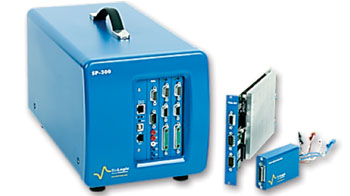Chemosensor Detects Cancer Biomarker Neopterin
By LabMedica International staff writers
Posted on 02 Jun 2016
A procedure has been established of molecular imprinting; a synthetic polymer receptor for the neopterin cancer biomarker was devised and used as a recognition unit of a potentiometric chemosensor.Posted on 02 Jun 2016
Cancer is no longer a death sentence for the patient, but the best chances of recovery are when the correct treatment is undertaken at an early stage of the disease. This is where the trouble starts, because many tumors develop over a long period without any symptoms.

Image: The SP300 electrochemistry system (Photo courtesy of BioLogic Science Instruments).
Scientists at the Institute of Physical Chemistry of the Polish Academy of Sciences (Warsaw, Poland) devised and fabricated a chemosensor system that will bring us a step closer to the sort of personalized medical diagnosis and cancer prophylaxis in the near future. The most important element of the devised chemosensor is a thin film of the polymer that detects molecules of neopterin. Neopterin, in chemical terminology known as 2-amino-6-(1,2,3-trihydroxypropyl)-1H-pteridin-4-one), is an aromatic compound present in human body fluids, such as serum, urine, and cerebrospinal fluid.
The concentration of this neopterin biomarker rises significantly particularly in the case of certain neoplastic diseases, e.g., malignant lymphoma, although elevated levels of neopterin are also seen in some viral and bacterial infections, as well as in diseases of parasitic etiology. In turn, in transplant patients, increased levels of neopterin signal probable rejection. The device has a recognizing polymer film with molecular cavities from neopterin has been produced on the surface of an electrode. Electrochemical experiments involving the potentiodynamic, cyclic voltammetry(CV), and open circuit potential (OCP) measurements were performed with an SP300 electrochemistry system (BioLogic Science Instruments, Claix, France).
After immersion in artificial blood serum spiked with neopterin, the film on the electrode captured molecules of the latter, thus leading to a decrease in electrical potential in the connected measuring system. The tests showed that the molecular cavities of the polymer were almost entirely filled with molecules of neopterin despite the presence of molecules of similar structure and properties. This result means that the probability of false positive detection (detecting the presence of neopterin in body fluids not containing it) is negligibly small. The new chemical sensor therefore mainly reacts to what it should react to - and nothing else.
Wlodzimierz Kutner, PhD, DSc, a professor of Chemistry and lead author of the study said. “At present, our chemosensor is a piece of laboratory equipment. However, the production of its key element, that is, the recognizing polymer film, does not pose major problems, and the electronics responsible for electrical measurements can easily be miniaturized. There is nothing standing in the way of building simple and reliable diagnostic equipment, based on our development, in just a few years' time, which would be affordable for medical institutions and doctors' surgeries.” The study was published on March 15, 2016, in the journal Biosensors and Bioelectronics.
Related Links:
Institute of Physical Chemistry of the Polish Academy of Sciences
BioLogic Science Instruments













